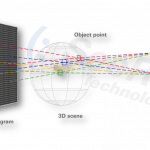How does it work … Holography
People use the term hologram for many things – mostly for things that are not holograms … But what makes a real hologram or what is holography?
Light propagates in space in the form of waves – similar to waves visible on a water surface. Laser light has the special property of being coherent. That means light waves from a laser have a fixed wavelength (for instance red only) and also a fixed relation of their phases, so all waves propagate in sync. With 3 lasers in red, green and blue, one can generate all other colors.
If several coherent light waves meet at a certain position in space they interfere: that means their amplitudes can either sum up to a larger value (constructive interference) or cancel out each each other to a smaller or even 0 value (destructive interference). Coherent light from lasers differs in this regard from incoherent light sources (e.g. your incandescent light bulb or a LED) where the intensities can also sum up to larger values but never cancel each other out.
In a holographic display, which is illuminated by a laser, each pixel of the display sends out light waves – the phase of the light wave is modulated by driving the display. Changing the phase basically is a defined delay of light from one pixel compared to other pixels. One can do this for instance with a suitable LCD.
By choosing certain phase values for neighboring pixels then, similar to focusing light with a lens, light waves from these pixels can be made to interfere constructively at certain positions in space. At those positions light from all those pixels sums up in order to generate a bright point in space – a 3D pixel if you like. The 3D space seen from an observer position towards the holographic display and beyond can be completely filled with 3D pixels at any depth position in front or behind the physical display screen, all in the same high resolution you know from HDTV. So different from other types of displays that generate flat images on the screen, for holography it is possible to really generate 3D points in space, each with its own color and brightness.
One may say „I don’t care how it works but I know 3D displays from my electronics store. What do I need complicated holography for?“ The truth in this statement is that only the features to an observer matter, so holography must deliver additional value. And it does, as explained in more detail on the Technology page and elsewhere. Regular flat panel displays generate flat 2D images. Stereo 3D does the same but with individual images for each eye (each gets its own perspective) – but the flat images differ from what one is used from seeing in real life. Real objects are not on a flat surface. They are anywhere in space – some very close, some far away. So real 3D provides additional visual information to the brain, like eye focus or motion parallax. The deeper the 3D, the more sensitive people get to the missing visual information of Stereo 3D. This may show in eye fatigue or even headaches, or one simply cannot fuse the two views and sees double images. The fact that holographic 3D generates the same visual information as a real environment is the key motivator for realizing holographic displays. Once it’s perfectly done, one cannot distinguish between a real object and a holographically reconstructed virtual object.






